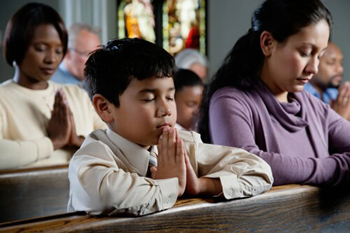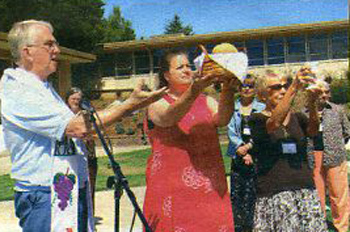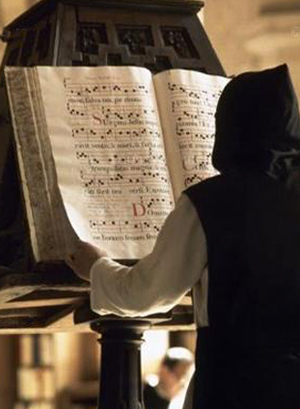Traditionalist Issues
 |
 |
 |
 |
 |
 |
 |
Dialogue Mass - I
A Plea for Silent Participation in the Liturgy
By common consent, the post-Vatican II Hierarchy of the Church maintains that “active participation” of all the faithful in the liturgy is “the aim to be considered before all else” (1) – even, as it turned out, before respect for Tradition, reverence for the Blessed Sacrament, a sense of the transcendent, or decorum and modesty in the house of God.
Just how did the Bishops arrive at this astonishing conclusion? By falsely presenting the reforms they have implemented as a continuation of the work of Pope Pius X whose motu proprio, Tra le Sollecitudini (TLS) first contained the word “active” in its Italian (though not, significantly, in its Latin) version to describe lay participation in the Mass.

Praying silently at Mass, a centuries long tradition
“Activity” had never been a defining characteristic of lay participation at Mass throughout the Church’s history. Therefore, some explanation is needed as to why it suddenly acquired an overwhelming significance in the early part of the 20th century and how it came to have a far reaching effect in the Liturgical Movement.
History has shown that the single word “active” created a Mexican wave that rippled through the 20th century, gathering momentum as it went, until it engulfed the entire Church with the blessing of Vatican II’s Constitution Sacrosanctum Concilium on the Liturgy (1963). Ever since, “active participation” has taken on a life of its own and continues to be reinforced with a zeal surpassed only by the hostility of the reformers for the traditional Latin Mass.
We know from one of the progressivist Fathers of Vatican II, Card. Godfried Danneels of Belgium who had been involved in drafting the Constitution on the Liturgy, that the aim of “active participation” was to democratize the liturgy by blurring the distinction between priestly and lay roles:
“From its very beginnings, the aim of the liturgical movement, which originated in Belgium in 1909, was to close the gap between the official liturgy of the priest and that of the people. The term ‘active participation’ was born out of this movement and has since become part of our common usage.” (2)

Active participation makes lay people equal to priests
From this we learn that the priest, through the Sacrament of Ordination, acts in the name of the Church, in an official act of the liturgy. Lay people, however, by virtue of their Baptism, merely associate themselves with the official liturgy through internal participation (by faith and prayer).
The result of the new emphasis on “active participation” was that the people in the pews, who had generally participated in the ceremonies of the Roman rite in silence, were now transformed into rivals in a liturgical war with the clergy over the right to officiate in the public prayer of the Church.
St. Pius X’s intentions
The subject matter of Tra le Sollecitudini was the restoration of sacred music, particularly Gregorian chant, in the Church’s liturgy. Its purpose was to lay down the true principles of liturgical music, both vocal and instrumental, to be disseminated throughout the world.
It is of the greatest importance to our study that this motu proprio was not about congregational singing in the liturgy but about the clergy and the choir as the only legitimate executors of liturgical chant. It laid down no obligation for the congregation to join in the chant or requirement for lay people (apart from selected choir members) to be trained in liturgical singing. Nor did it state or even imply that silence on the part of the congregation indicated an absence or deficiency in their full participation in the liturgy.
Some points of concern
The motu proprio was first published in Italian on November 22, 1903, in the Acta Sanctae Sedis, the official organ of the Holy See, but the Latin version bearing the same date did not see the light of day until much later, after many intervening documents. Both texts can be accessed here. (4)

Pope Pius X's aim was to reform Gregorian chant, not active participation
Another notable anomaly is the manner in which the Latin version is dated. Instead of the customary format found in the Acta Sanctae Sedis since 1865, it was written according to the method of calculation of the ancient Romans as X Kalendas Decembris. Thus the impression is given that the Latin text had been composed long after TLS, as if it were an afterthought and of relative unimportance. Only those who are familiar with the ancient dating system would realize that X Kalendas Decembris is, in fact, the equivalent of November 22, the same date as TLS. (5)
This has prompted some to assume that the Italian version, simply because it appeared first, is the official papal text. (6) TLS may be “official” in the sense of having been published by officials of the Vatican bureaucracy, but the fact remains that the Latin is invariably the only authoritative and official version of papal documents, even if it happens that this text only becomes available later.
Out of sight, out of mind
Therefore, it is to be deplored that the Latin version was buried from immediate view and relegated to an inconvenient position. To add to the difficulties in locating the Latin text, the page number in the Acta Sanctae Sedis was printed as 587 instead of 387, thus misdirecting the researcher.
Why such obfuscation surrounding the only version of the motu proprio (i.e. the Latin) that conveys in indisputable terms the mind of the Pope? The answer will become clear when we come to examine the important discrepancies between the two documents.
Which version to follow – the Italian or Latin?
As the use of Latin in drafting documents was considered by the Church as the ultimate safeguard of objectivity, it is vitally important for the faithful transmission of the truth in a seamless way. Later generations of Catholics can recognize in the Latin words the exact meaning intended by the Popes. Thus it averted the risk of misleading the faithful through imprecise formulae or the rapid changes in meaning typical of vernacular languages.
As we shall see, misrepresentation is exactly what happened when TLS was placed into the hands of liturgical reformers. An examination of this document will show that it contains a number of key words and phrases for which there is no translational equivalence in the Latin version.
In other words, ideas had been inserted into TLS that pander to the aims and objectives of those who wanted to change the liturgy in ways not envisaged by Pope Pius X. Someone even managed to get the word attiva (“active”) written into the text of TLS to describe the participation of the laity, a term entirely missing in the Latin version.
It is noteworthy that the reformers could not have misinterpreted the Pope’s words in the Latin version because it was drafted with tamper-proof precision designed to give the crystal clear meaning of the Pope and deny any wiggle room for liturgical interventionists. But, for all its official status, the Italian version, as with all documents in the vernacular, could offer no such guarantees. In fact, the more it was translated into other vernacular languages, the greater the confusion and error that was transmitted.
Continued
- Sacrosanctum Concilium, The Constitution on the Liturgy (1963), § 14
- Godfried Danneels, apud Keith Pecklers SJ, Liturgy in a Postmodern World, Continuum International Publishing Group Ltd, 2006, p. 7.
- “The visible, external priesthood of Jesus Christ is not handed down indiscriminately to all members of the Church in general, but is conferred on designated men, through what may be called the spiritual generation of Holy Orders" (§ 41), "Hence he [the priest] goes to the altar as the minister of Christ, inferior to Christ but superior to the people" (§ 84). When “speaking of the people offering with the priest,” the Church means only that the people “unite their hearts in praise, impetration, expiation and thanksgiving, with the prayers and intention of the priest, even of the High Priest Himself” (§ 93).
- Acta Sanctae Sedis, Vol. XXXVI, 1903-1904, p. 329; for the Italian version, p. 387 (misprinted as 587) for the Latin version.
- The ancient Romans calculated their dates backwards by subtracting the stated number of days in the date from a fixed point in each month. As the Kalendae designated the first day of every month, if we count back 10 days inclusively from December 1, we come to November 22. So X Kalendas Decembris = 22 November.
- A motu proprio means that the Pope was acting on his own initiative in creating new legislation rather than merely rubber-stamping a decree issued by a department of the Curia. The drafting of TLS was largely the work of Fr Angelo de Santi, SJ, Founder of the Pontifical Institute for Sacred Music, who had been closely associated with the Pope’s musical reforms when the latter was Bishop of Mantua and Patriarch of Venice. (See Robert Hayburn, Papal Legislation on Sacred Music: 95 AD to 1977 AD, Collegeville: Liturgical Press, 1979, p. 220.)

Posted February 26, 2014
______________________
______________________
 Volume I |
 Volume II |
 Volume III |
 Volume IV |
 Volume V |
 Volume VI |
 Volume VII |
 Volume VIII |
 Volume IX |
 Volume X |
 Volume XI |
 Special Edition |


